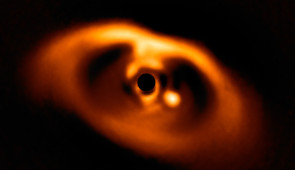
Young exoplanet’s atmosphere unexpectedly differs from its birthplace
New study shows planet formation might be more complicated than previously thought
- Link to: Northwestern Now Story
EMBARGOED UNTIL 4 A.M. EST (U.S.) ON WEDNESDAY, DECEMBER 18, 2024
- Conventional wisdom assumes the ratio of gases in a planet’s atmosphere should match the ratio of gases in the natal disk that birthed it
- For the first time, researchers compared gases in a still-forming planet’s atmosphere to its natal disk
- Team found the planet surprisingly was less carbon-rich than the disk
EVANSTON, Ill. --- Just as some children physically resemble their parents, many scientists have long thought that developing planets should resemble the swirling disk of gas and dust that births them.
But, in a new study, a Northwestern University-led team of astrophysicists discovered the resemblance might be looser than previously thought. By studying a still-forming exoplanet and its surrounding natal disk using new instrumentation at W.M. Keck Observatory, the researchers uncovered a mismatched composition of gases in the planet’s atmosphere compared to gases within the disk.
The surprising finding potentially confirms long-held skepticism that scientists’ current model of planet formation is too simplified.
The study was published on Wednesday (Dec. 18) in the Astrophysical Journal Letters. It marks the first time physicists have compared information from an exoplanet, its natal disk and host star.
“For observational astrophysicists, one widely accepted picture of planet formation was likely too simplified,” said Northwestern’s Chih-Chun “Dino” Hsu, who led the study. “According to that simplified picture, the ratio of carbon and oxygen gases in a planet’s atmosphere should match the ratio of carbon and oxygen gases in its natal disk — assuming the planet accretes materials through gases in its disk. Instead, we found a planet with a carbon and oxygen ratio that is much lower compared to its disk. Now, we can confirm suspicions that the picture of planet formation was too simplified.”
Hsu is a postdoctoral associate at the Center for Interdisciplinary Exploration and Research in Astrophysics (CIERA). He is advised by Jason Wang, an assistant professor of physics and astronomy at Northwestern’s Weinberg College of Arts and Sciences and member of CIERA.
Searching for visible birth material
All planets are born from a natal disk, a rotating disk of gas and dust that surrounds a new star. Over millions of years, gravity pulls gas and dust together to form clumps, which eventually grow into planets. Until recently, it was impossible to obtain a direct view of a natal disk in order to track a planet’s birth. Most observable exoplanets are too old, so their natal disks have already disappeared.
The exception, however, is PDS 70, a natal disk that envelopes two fledgling gas-giant exoplanets — similar to Jupiter — called PDS 70b and PDS 70c. Located just 366 lightyears from Earth within the constellation Centaurus, the planets are, at most, a youthful 5 million years old.
“This is a system where we see both planets still forming as well as the materials from which they formed,” Wang said. “Previous studies have analyzed this disk of gas to understand its composition. For the first time, we were able to measure the composition of the still-forming planet itself and see how similar the materials are in the planet compared to the materials in the disk.”
Examining planetary fingerprints
To measure the materials, Hsu, Wang and their team examined the light emitted from PDS 70b. This light, or spectra, is like a fingerprint, revealing an object’s composition, motion, temperature and other characteristics. Each molecule or element produces its own spectrum. So, by studying these spectra, researchers can pinpoint the specific molecules or elements within an object.
In previous work, Wang co-developed new photonics technologies at Keck Observatory that enable astronomers to capture the spectrum of targeted faint objects near much brighter stars. The researchers used this technique to zero in on the faint features of the young planetary system.
“These new tools make it possible to take a really detailed spectra of faint objects next to really bright objects,” Wang said. “Because the challenge here is there’s a really faint planet next to a really bright star. It’s hard to isolate the light of the planet in order to analyze its atmosphere.”
With the spectra, the researchers obtained information about carbon monoxide and water from PDS 70b. From that, they calculated the inferred ratio of carbon and oxygen within the planet’s atmosphere. Then, they compared that ratio to previously reported measurements of gases in the disk.
“We initially expected the carbon-to-oxygen ratio in the planet might be similar to the disk,” Hsu said. “But, instead, we found the carbon, relative to oxygen, in the planet was much lower than the ratio in the disk. That was a bit surprising, and it shows that our widely accepted picture of planet formation was too simplified.”
Solid components might make the difference
To explain this mismatch, Hsu and Wang think two different scenarios might be at play. One explanation is the planet might have formed before its disk became enriched in carbon. Another explanation is the planet might have grown mostly by absorbing large amounts of solid materials in addition to gases. While the spectra show only gases, some of the carbon and oxygen initially could be accreted from solid — trapped in ice and dust.
“If the planet preferentially absorbed ice and dust, then that ice and dust would have evaporated before going into the planet,” Wang said. “So, it might be telling us that we can’t just compare gas versus gas. The solid components might be making a big difference in the carbon to oxygen ratio.”
For this study, the team only studied PDS 70b. Next, they plan to observe the spectra from the other planet in the PDS 70 system.
“By studying these two planets together, we can understand the system’s formation history even better,” Hsu said. “But, also, this is just one system. Ideally, we need to identify more of them to better understand how planets form.”
The study, “PDS 70b shows stellar-like carbon-to-oxygen ratio,” was supported by the Heising-Simons Foundation, the Simons Foundation and the National Science Foundation.
Multimedia Downloads
Image of PDS 70
Interview the Experts


